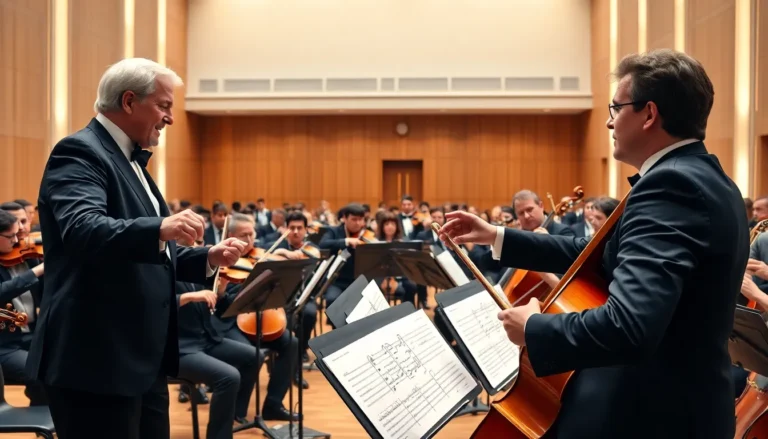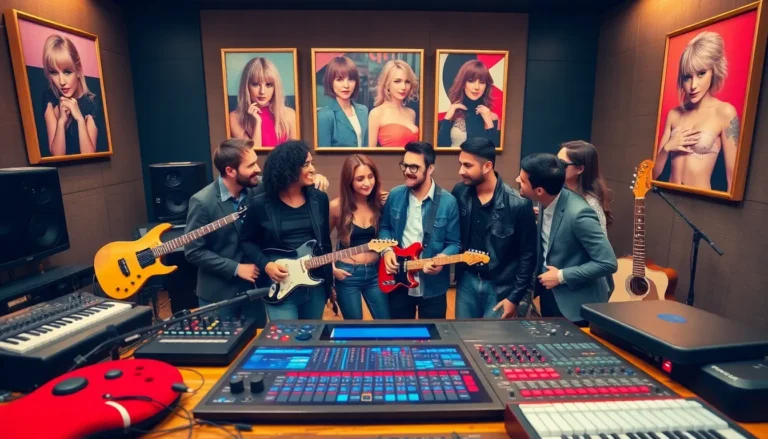Modern pop music is like a glittering kaleidoscope, constantly shifting and evolving. With catchy hooks and infectious beats, it captures hearts and dominates playlists worldwide. Whether it’s a breakup anthem or a dance floor banger, pop music knows how to tap into emotions and get people moving.
Table of Contents
ToggleOverview of Modern Pop Music
Modern pop music showcases a blend of influences and styles, continually evolving to capture the interests of diverse audiences. This genre thrives on its catchy melodies and accessibility, rising to the top of music charts globally. Artists often incorporate elements from various genres, including hip-hop, electronic, and R&B, resulting in a rich tapestry of sound.
Listeners frequently connect with pop music due to its relatable themes and emotional depth. Breakup ballads resonate with those experiencing heartache, while upbeat tracks encourage dancing and celebration. High-profile collaborations among artists further fuel pop music’s popularity, as these partnerships introduce fans to new sounds and create buzz around releases.
The digital age significantly impacts how pop music spreads and evolves. Streaming platforms play a crucial role in shaping listening habits, allowing fans to discover and share tracks effortlessly. Social media platforms amplify this effect by enabling artists to engage directly with their audience and promote their work instantly.
Data from recent studies highlight pop music’s dominance in global playlists, illustrating its wide reach. In 2022, pop music accounted for approximately 38% of all music streaming, showcasing its central role in contemporary culture. Innovations in production techniques and marketing strategies also contribute to the genre’s ongoing success.
Creativity thrives within the modern pop landscape, with artists pushing boundaries and redefining what pop music can be. Emerging trends include the use of interactive music videos and virtual reality experiences, enhancing audience engagement. As modern pop continues to evolve, it remains a powerful force in shaping musical trends and popular culture.
Key Characteristics of Modern Pop Music

Modern pop music features distinctive qualities that set it apart. These traits enhance its appeal and influence on listeners.
Melodic Elements
Catchy melodies define modern pop tracks. Hooks capture attention and linger in listeners’ minds. Versatility exists in chord progressions, often blending simple structures with unexpected shifts. Repetition in melodic phrases contributes to memorability. Many artists utilize uplifting tunes to evoke positive emotions. Trends show a clear preference for synth-driven sounds, which enhance the genre’s dynamic nature.
Lyrical Themes
Relatable lyrics resonate with diverse audiences. Common themes include love, heartbreak, and self-empowerment, appealing to listeners of various backgrounds. Emerging trends also highlight social issues, providing depth and relevance. Some artists infuse personal narratives into their songs, inviting connection. Emotional vulnerability often emerges, encouraging listeners to share experiences. Listeners respond positively to narratives that mirror their own feelings, solidifying pop music’s presence in everyday life.
Production Techniques
Innovative production techniques shape modern pop music. Electronic elements dominate, offering fresh sounds and textures. Many producers leverage technology to create polished tracks, ensuring high-quality output. Layering vocals adds richness, enveloping listeners in immersive experiences. The use of sampling from various genres broadens sonic possibilities, fostering creativity. Collaboration among artists and producers enhances the final product, driving the genre’s evolution.
Influential Artists in Modern Pop Music
Modern pop music thrives on both new faces and established veterans. These artists shape the genre, demonstrating its diverse appeal through unique styles and contributions.
Emerging Stars
Emerging stars ignite the modern pop scene with fresh sounds and intriguing concepts. Olivia Rodrigo has captivated audiences with her emotionally charged lyrics and catchy melodies. Lil Nas X pushes boundaries, seamlessly blending pop with hip-hop influences. Dua Lipa combines retro vibes with contemporary beats, creating danceable anthems that resonate widely. These artists represent a new generation dedicated to innovation within the genre, connecting deeply with listeners.
Established Icons
Established icons continue to dominate the pop landscape, solidifying their influence over time. Taylor Swift’s storytelling prowess elevates her songs, ranging from country roots to mainstream pop. Bruno Mars brings a mix of funk and R&B that appeals across demographics. Beyoncé’s powerful vocals and empowering messages inspire countless fans globally. Their enduring popularity reflects their ability to adapt while maintaining authentic connections with audiences, reinforcing pop music’s cultural significance.
The Evolution of Modern Pop Music
Modern pop music continues to transform rapidly. This evolution reflects shifts in culture, technology, and listener preferences.
Historical Context
Pop music’s roots trace back to the early 20th century with jazz, swing, and rock influences shaping its development. The 1960s and 1970s marked a pivotal period, introducing artists like The Beatles and Elvis Presley. Their innovative styles established pop as a dominant genre. Synth-pop emerged in the 1980s, characterized by electronic instrumentation, setting the stage for future trends. The 1990s saw the rise of teen pop, exemplified by artists such as Britney Spears and NSYNC, who captivated young audiences. As digital technology advanced, pop music transitioned to online platforms, revolutionizing accessibility and distribution. In 2022, pop music represented roughly 38% of all music streams, underscoring its enduring relevance in contemporary culture.
Genre Blending
Genre blending became a prominent feature of modern pop music. Artists frequently incorporate elements from hip-hop, electronic, and R&B genres into their tracks. This fusion attracts diverse audiences, creating a broader appeal. For example, Billie Eilish merges pop with electronic and alternative influences, offering a unique sound. Collaborations among artists further enhance this blend, producing innovative tracks that resonate widely. Additionally, the inclusion of varied musical styles allows pop artists to reach different demographics. Emerging acts like Lil Nas X exemplify this trend, effortlessly combining country and pop elements. Such cross-genre experimentation continues to redefine pop music.
Impact of Technology on Modern Pop Music
Technology profoundly reshapes modern pop music, enhancing its reach and influence. Key advancements include streaming platforms and social media, each playing a vital role in how audiences consume and engage with music.
Streaming Platforms
Streaming platforms revolutionized music distribution and listening habits. Spotify, Apple Music, and YouTube dominate the industry, providing instant access to vast music libraries. Approximately 38% of all music streaming in 2022 came from pop, reflecting its popularity. These platforms allow algorithms to tailor recommendations, helping listeners discover new artists and tracks. User-generated playlists further amplify the genre’s visibility. Artists leverage these platforms to release singles, often generating buzz before album drops. Independent musicians gain exposure alongside industry giants without traditional gatekeeping barriers.
Social Media Influence
Social media platforms significantly enhance artist-audience connection. Instagram, TikTok, and Twitter enable artists to engage directly with fans, sharing behind-the-scenes content and personal insights. Viral challenges and trends on TikTok drive songs to global popularity, creating overnight sensations. These platforms foster community and encourage fan-generated content, amplifying exposure. Hashtags serve as marketing tools, connecting users to upcoming releases or live performances. With real-time feedback, artists adjust their approaches, responding to audience preferences and trends quickly. Engagement on social media solidifies the relevance of pop music in contemporary culture.
Modern pop music stands as a testament to the genre’s adaptability and cultural significance. With its catchy melodies and relatable themes it continues to capture the hearts of listeners worldwide. The fusion of various musical styles keeps the genre fresh and engaging while emerging technologies reshape how music is consumed and experienced.
As pop artists push creative boundaries through collaboration and innovative production techniques they ensure the genre remains at the forefront of the music industry. The ongoing evolution of pop music reflects not only changing tastes but also the power of music to connect people across generations. This vibrant genre will undoubtedly continue to thrive and resonate in the years to come.



